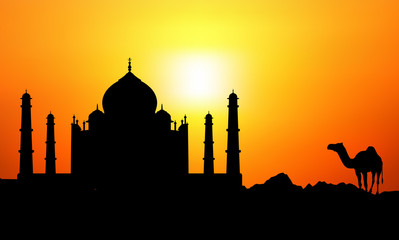Embark on a journey to one of the most iconic landmarks in the world with the Taj Mahal and Agra Tour by Car from Delhi. Prepare to be captivated by the sheer magnificence and exquisite beauty of this architectural masterpiece. Standing tall in all its splendor, the Taj Mahal is a testament to the eternal love between Emperor Shah Jahan and his beloved wife Mumtaz Mahal.
A Taj Mahal and Agra Tour by Car from Delhi is not just a sightseeing experience; it is a journey into the heart of India’s rich cultural heritage. From the moment you step foot inside the complex, you will be enveloped in a sense of wonder and awe. Whether you are an architecture enthusiast, a history buff, or simply seeking a magical experience, a visit to the Taj Mahal will leave an indelible mark on your soul.
As you explore the Taj Mahal, you will be immersed in its fascinating history and exceptional craftsmanship. Marvel at the intricate details of the marble facade, adorned with precious gemstones, and be transported to a bygone era. The delicate minarets, reflecting pools, and meticulously manicured gardens create a serene and ethereal atmosphere, offering the perfect backdrop for capturing timeless memories.
Come, explore the Taj Mahal, and witness the allure of this sublime wonder of the world.
The Taj Mahal, often referred to as the “Crown of Palaces,” was built by Emperor Shah Jahan in the 17th century as a mausoleum for his beloved wife, Mumtaz Mahal. The construction of this architectural marvel began in 1632 and took 22 years to complete. The Taj Mahal is a symbol of everlasting love and a monument to the grief-stricken Emperor’s devotion to his wife.
The significance of the Taj Mahal extends beyond its romantic origins. It is recognized globally as a UNESCO World Heritage Site and is considered one of the New Seven Wonders of the World. Its architectural brilliance and cultural significance make it an integral part of India’s rich history and heritage.
The Taj Mahal is not just a physical structure but a testament to the Mughal era’s grandeur and artistic prowess. Its construction involved thousands of skilled craftsmen, including architects, calligraphers, and artisans, who meticulously created every intricate detail of this masterpiece. The Taj Mahal’s architectural style is a fusion of Persian, Islamic, and Indian influences, resulting in a harmonious blend of elements.
Architecture and design of the Taj Mahal
The Taj Mahal’s architecture and design are nothing short of breathtaking. The entire complex is a symmetrical masterpiece, with the mausoleum at its center and four minarets at each corner. The mausoleum’s main structure is made of white marble, which changes its color with the varying intensity of sunlight. The intricate carvings and inlay work, known as “pietra dura,” are made from precious gemstones, including jade, crystal, turquoise, and lapis lazuli.
The Taj Mahal’s main dome is its most striking feature, rising to a height of 73 meters and crowned with a golden finial. It is surrounded by four smaller domed chhatris, which enhance the overall architectural balance. The minarets, standing at a height of over 40 meters, not only serve as decorative elements but also provide a sense of scale and grandeur. The entire complex is surrounded by lush green gardens, meticulously laid out in the traditional charbagh style, symbolizing paradise.
The Taj Mahal’s architectural brilliance lies in its perfect symmetry and intricate detailing. The use of geometric patterns, calligraphy, and floral motifs creates a visually stunning masterpiece that has stood the test of time.
Interesting facts about the Taj Mahal
The Taj Mahal’s construction required the labor of approximately 20,000 workers, including artisans and craftsmen from all over the world. The white marble used to build the Taj Mahal was transported from Makrana, Rajasthan, a distance of over 300 kilometers. The Taj Mahal appears to change color depending on the time of day. It appears pinkish in the morning, milky white in the evening, and golden under the moonlight. The calligraphy on the Taj Mahal’s facade is not painted but carved into the marble. It is said that the calligraphers used precious gemstones to create the intricate patterns. The Taj Mahal is an architectural marvel, designed to withstand earthquakes. The minarets are built slightly outward, so in the event of an earthquake, they would fall away from the main structure and protect it from damage.
How to reach the Taj Mahal
Best time to visit the Taj Mahal
Taj Mahal ticket prices and entry timings
Exploring the Taj Mahal complex
Inside the mausoleum, you will find the cenotaphs of Emperor Shah Jahan and Mumtaz Mahal, beautifully decorated with inlaid gemstones. The actual tombs are located in the lower level, which is not open to the public. The interior of the mausoleum is adorned with intricate floral motifs and calligraphy, depicting verses from the Quran.
As you explore the Taj Mahal complex, take a leisurely stroll through the lush gardens and enjoy the serene ambiance. The reflecting pools, known as the “Pond of Paradise,” offer a picturesque view of the Taj Mahal’s reflection, especially during the early morning hours.




 its many Mughal-era buildings, most notably the Taj Mahal, Agra Fort and Fatehpūr Sikrī, all of which are UNESCO World Heritage Sites. Agra is included on the #Golden Triangle tourist circuit, along with Delhi and Jaipur; and the Uttar Pradesh Heritage Art, tourist circuit of UP state, along Lucknow and Varanasi. Agra falls within the Braj cultural region. The city was first mentioned in the epic Mahābhārata, where it was called Agrevaṇa, the 11th-century Persian poet Salmān writes of a desperate assault on the fortress of Agra, then held by the Shāhī King Jayapala, by Sultan Mahmud of Ghazni. It was mentioned for the first time in 1080 AD when a Ghaznavide force captured it. Sultan Sikandar Lodī (1488–1517) was the first to move his capital from Delhi to Agra in 1506. He governed the country from here and Agra assumed the importance of the second capital. He died in 1517 and his son, Ibrāhīm Lodī, remained in power there for nine more years and several palaces, wells, and a mosque were built by him in the fort during his period, finally being defeated at the Battle of Panipat in 1526. Between 1540 and 1556, Afghans, beginning with Sher Shah Suri ruled the area. There are many interesting places will you like Taj Mahal, Et-mad –UD Daullah, Agra Fort, Fatehpur Sikri, Sikandra, Dayalbagh, Chini Ka Roza, At all these places you see beautiful arts and architecture…In evening Time Taj Mahal looks like a heaven of the earth. Its beauty is really Amazing. If you want to visit this wonderful tour so book your Taj Mahal Overnight Tour now very expandable price.
its many Mughal-era buildings, most notably the Taj Mahal, Agra Fort and Fatehpūr Sikrī, all of which are UNESCO World Heritage Sites. Agra is included on the #Golden Triangle tourist circuit, along with Delhi and Jaipur; and the Uttar Pradesh Heritage Art, tourist circuit of UP state, along Lucknow and Varanasi. Agra falls within the Braj cultural region. The city was first mentioned in the epic Mahābhārata, where it was called Agrevaṇa, the 11th-century Persian poet Salmān writes of a desperate assault on the fortress of Agra, then held by the Shāhī King Jayapala, by Sultan Mahmud of Ghazni. It was mentioned for the first time in 1080 AD when a Ghaznavide force captured it. Sultan Sikandar Lodī (1488–1517) was the first to move his capital from Delhi to Agra in 1506. He governed the country from here and Agra assumed the importance of the second capital. He died in 1517 and his son, Ibrāhīm Lodī, remained in power there for nine more years and several palaces, wells, and a mosque were built by him in the fort during his period, finally being defeated at the Battle of Panipat in 1526. Between 1540 and 1556, Afghans, beginning with Sher Shah Suri ruled the area. There are many interesting places will you like Taj Mahal, Et-mad –UD Daullah, Agra Fort, Fatehpur Sikri, Sikandra, Dayalbagh, Chini Ka Roza, At all these places you see beautiful arts and architecture…In evening Time Taj Mahal looks like a heaven of the earth. Its beauty is really Amazing. If you want to visit this wonderful tour so book your Taj Mahal Overnight Tour now very expandable price.



